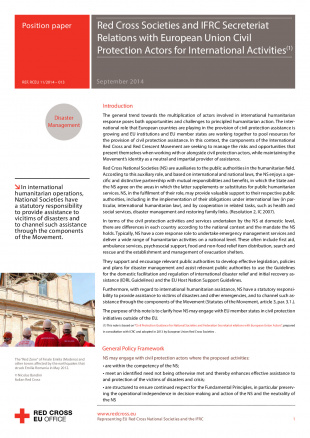Red Cross Red Crescent relations with EU civil protection actors for international activities
Introduction
The general trend towards the multiplication of actors involved in international humanitarian response poses both opportunities and challenges to principled humanitarian action. The international role that European countries are playing in the provision of civil protection assistance is growing, and EU institutions and EU Member States are working together to pool resources for the provision of civil protection assistance. In this context, the components of the International Red Cross and Red Crescent Movement seek to manage the risks and opportunities that present themselves when working with civil protection actors, while maintaining the Movement’s identity as a neutral and impartial provider of assistance.
Red Cross National Societies are auxiliaries to the public authorities in the humanitarian field. According to this auxiliary role, and based on international and national laws, they enjoys a specific and distinctive partnership with mutual responsibilities and benefits. In fulfilling this role, Red Cross Societies may provide valuable support to their respective public authorities, including in the implementation of their obligations under international law (in particular, international humanitarian law), and by cooperation in related tasks, such as health and social services, disaster management and restoring family links.
In terms of the civil protection activities and services undertaken by the National Societies at the domestic level, there are differences in each country according to the national context. Typically, they have a core response role to undertake emergency management services and deliver a wide range of humanitarian activities. These often include first aid, ambulance services, psychosocial support, food and non-food relief item distribution, search and rescue and the establishment and management of evacuation shelters.
They support and encourage relevant public authorities to develop effective legislation, policies and plans for disaster management and support the application of the Guidelines for the domestic facilitation and regulation of international disaster relief and initial recovery assistance (IDRL Guidelines) and the EU Host Nation Support Guidelines.
Furthermore, with regard to international humanitarian assistance, National Societies have a statutory responsibility to provide assistance to victims of disasters and other emergencies, and to channel such assistance through the components of the Movement
This note aims to clarify how National Societies can engage with EU Member States in civil protection initiatives outside of the EU.
General Policy Framework
National Societies may engage with civil protection actors where the proposed activities:
- are within the competency of the National Societies;
- meet an identified need not being otherwise met and thereby enhances effective assistance to and protection of the victims of disasters and crisis;
- are structured to ensure continued respect for the Fundamental Principles, in particular preserving the National Society’s neutrality and its operational independence in decision-making and action;
- ensure continued respect for the relevant rules and policies adopted by the Movement and the Federation, in particular the rules on cooperation and established coordination mechanisms and the rules on the use of the emblem;
- consider the safety and security issues of beneficiaries and humanitarian personnel, including the potential consequences for other components and the positioning of the Movement as a whole;
- preserve the National Society’s capacity to act in the longer term, and;
- preserve the reputation of the Movement and meets recognised minimum standards of quality and accountability in humanitarian action.
The Red Cross, Red Crescent and Red Crystal emblems or the National Society’s name or logo shall only be used in deployments with civil protection actors on the basis of the emblem regulations in force and if:
- The National Society retains the management control over such assets and resources;
- such use is agreed by the National Society in the disaster-affected country and the International Federation; in the case of the International Federation’s logo, the International Federation agrees; and
- the use of the emblems is not considered a risk to the perceived independence and neutrality of the Red Cross Red Crescent response, nor a potential threat to safety, security or access of any staff or volunteers
Assets or resources may be loaned or deployed to civil protection operations, without any Red Cross and Red Crescent emblems or logos, if such deployment would not weaken the Movement’s capacity to respond.
Relationships with the European Response Coordination Centre
The Red Cross EU Office, on behalf of the IFRC and European Union Red Cross Societies liaises with the European Response Coordination Centre. (ERCC). The ERCC exchanges information, requests for assistance, crisis and situation reports by email with the EU Member States. The Red Cross EU Office shares this information with NS to ensure that they are aware of the activity of the ERCC in a specific crisis. According to the new EU legislation on civil protection, international organisations can request European civil protection assistance. Any request by the IFRC for the ERCC to deploy civil protection assets would be:
- based upon a request from the government and the agreement of the NS in the affected state for assistance
- in technical areas and for human resource skill sets and equipment where the IFRC does not maintain assets or where other humanitarian organisations are unable to respond in a timely manner
- in coordination with, not coordinated by, the IFRC – i.e. maintaining the operational independence in decision-making and action of both the IFRC and deployed Civil Protection asset.
Theme


